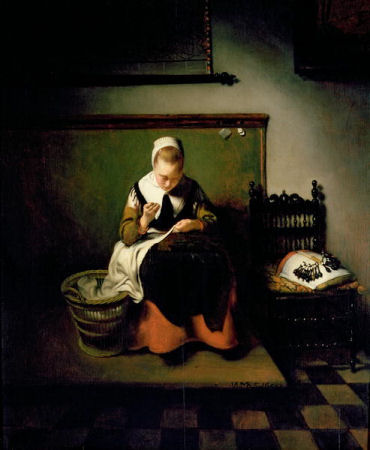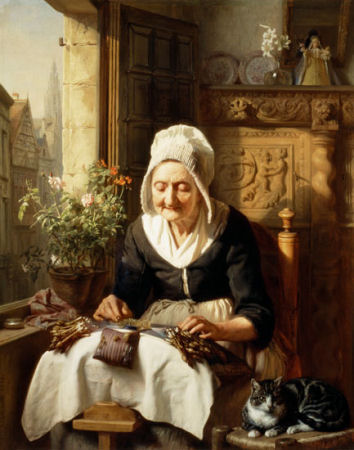

Pins are essential for making bobbin lace. A Dutch play of 1642 calls the trade of making bobbin lace spelderwerkster which means 'pin worker'.

Pins are cheap, and easy to buy from a haberdashery or sewing shop, although lace suppliers naturally sell them as well. You do need a lot, and they must have small heads. A bobbin lace pattern needs to fit a large number of pins in a small space, so if the pins had, for example, glass heads, they would not fit in the space.

Pins in use, making bobbin lace
Pins last well. I have managed to bend one or two, and I continually drop them on the floor. "See a pin, pick it up, all the day you'll have good luck!"
I found this quote in a book "History of Lace" by Mrs. Bury Palliser, published originally in 1875. I don't know how accurate it is, but she seems to be careful with her references, and quotes dates, and so on. She says "In 1651, Jacob v. Eyck, a Flemish poet, sang the praises of lace-making in Latin verse:
"Of many arts one surpasses all; the threads woven by the strange power of the hand, threads which the dropping spider would in vain attempt to imitate, and which Pallas would confess she had never known; For the maiden, seated at her work, plies her fingers rapidly, and flashes the smooth balls and thousand threads into the circle, Often she fastens with her hand the innumerable needles, to bring out the various figures of the pattern; often again, she unfastens them; and from this, her amusement makes as much profit as a man earns by the sweat of his brow; and no maiden ever complains at even of the length of the day. The issue is a fine web, open to the air with many an aperture, which feeds the pride of the whole globe; which surrounds with its fine border cloaks and tuckers, and shows grandly round the throats and hands of kings; and, what is more surprising, this web is of the lightness of a feather, which in its price is too heavy for our purses. Go, ye men, inflamed with desire of the Golden Fleece, endure so many dangers by land, so many at sea, whilst the woman, remaining in her Brabantine home, prepares Phrygian fleeces by peaceful assiduity."
A little glossing: Pallas Athene was the Greek goddess of domestic crafts. Jason and the Argonauts were Greek heros who sailed to find the Golden or Phrygian Fleece. Brabant was a duchy in 1651, including the city of Brussels, which was famous for bobbin lace. When he says needles, he means pins, and the 'balls' are the bobbins, which had balls at the ends.
The description of making lace is wonderful. The 'thousand threads' are exaggerated, but with the 'innumerable needles' show that we are talking about a large piece of lace. The 'circle' must be the pillow, or perhaps the circle of bobbins round the lace being worked, although the later 'globe' is the world. It describes the movement of the bobbins, and putting in and taking out pins. It also describes how it's used, to trim cloaks and tuckers, and provide collars and cuffs for kings. I like the comparison of the lightness of the lace and the 'heaviness' of the price!

This lacemaker is by Nicolaes Maes, painted around 1655. She is sewing, with her lace pillow carefully put on a chair. You can see the 'balls' at the end of the bobbins, and the circle of bobbins. The pins are there, although hard to see.

This is called The Old Lacemaker, by Josephus Laurentius Dyckmans who lived from 1811 to 1888. He was born in Lier, Holland and settled in Antwerp, Belgium in 1833. There are a lot of pins (and bobbins) on this lacemaker's pillow, plus a useful pin cushion to hold the pins.
The Dutch for pins is Spelden.
© Jo Edkins 2016 - return to lace index